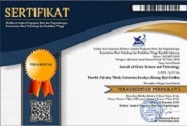ANALYSIS OF THE JALAWASTU AREA AS A SUSTAINABLE CULTURAL TOURISM
Abstract
Full Text:
PDFReferences
Akhmad Ramdhon, 2009, Revitalisasi Tradisi, Pariwisata dan Skema Ekonomi-Politik Kota
Ashworth, G. J. dan Tunbridge, J. E., 1990, The Tourist-Historic City, Belhaven Press, London & New York.
Bovy, M.B. & Lawson, F., 1977. Tourism and Recreation Development. Massachusetts: CBI Publishing Company.
Gunn, Clare A. And Var, Turgut. 2002. Tourism Planning: Basic Concepts Cases, Taylor & Francis Books Inc: New York.
Heritage Site Managers”, dipublikasikan UNESCO World Heritage centre, 2002
Priono Yesser. Identifikasi Produk Wisata Pariwisata Kota (Urban Torism) Kota Pangkalan Bun Sebagai Urban Heritage Tourism. Jurnal prespektif arsitektur Volume 7/No.2, Desember 2020.
Sugiyarto, 2018. Pengembangan Pariwisata Berbasis Budaya dan Kearifan Lokal. Jurnal Administrasi Bisnis. Volume 7, Nomor 1, Maret 2018, pp. 45-52
Warpani, P, Suwardjoko, Warpani, P, Indira,2007, “Pariwisata Dalam Tata Ruang Wilayah”, Bandung: ITB
Wilopo, Khusnul Khotimah. 2017. Strategi Pengembangan Destinasi Pariwisata Budaya. Jurnal Administrasi Bisnis (JAB)|Vol. 41 No.1 Januari 2017
Winter, T. 2004, i‘Cultural Heritage and Tourism in Angkor’, Cambodia: Developing a Theoretical Dialogue.
DOI: http://dx.doi.org/10.33603/jgst.v5i1.4968
Refbacks
- There are currently no refbacks.











